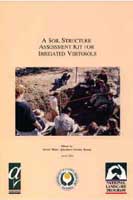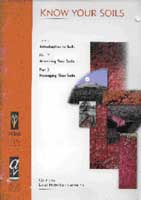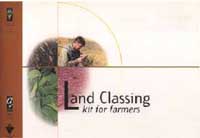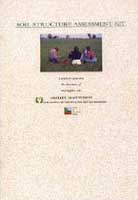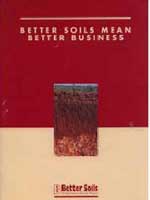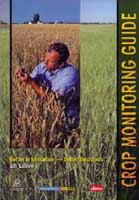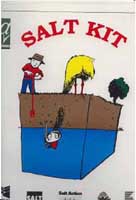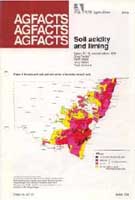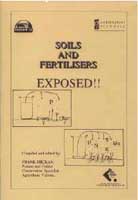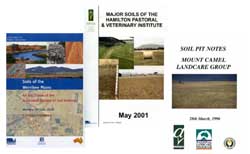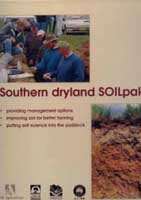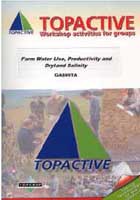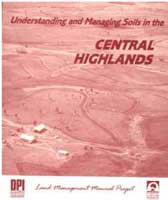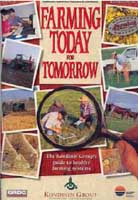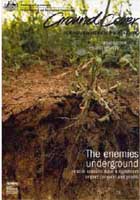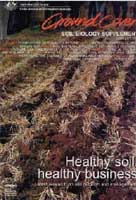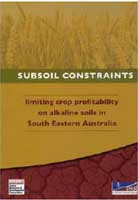Back to: Review of soil extension materials used by DPI and partners
1. Review of soil extension materials used by DPI and partners - March 2007 | 2. Programs/Learning Guides | 3. Brochure/Booklets | 4. Information Notes | 5. Education Manuals | 6. Departmental Videos | 7. Posters
1. Review of soil extension materials used by DPI and partners - March 2007
| A Soil Structure Assessment Kit for Irrigated Vertosols
|
Edited by Russell Mann
Former Agriculture Victoria, Kerang
April 1995
ISBN 0 7306 64384
Summary
Developed as an educational aid for landholders in dryland cropping, sheep grazing and irrigated agriculture, predominantly in northern Victoria and with a focus on irrigated Vertosols. Enables readers to assess and monitor the structure of their soil. It aims to increase their knowledge of soil, soil structure and how management practices can affect soil structure. | |
Format
Booklet of 19 pages with coloured photographs and illustrations.
Intended Users
Intended as a self-explanatory kit for farmers and extension officers - but may be best for users to be taken through it with an extension officer in the first instance.
Useful Features
- Technical information combined with exercises for hands on learning.
- Provides useful information on seven soil properties and how to rate them to determine the soil properties that limit plant growth.
- Can assist to monitor the changes in structure over time and determine whether it is improving.
- Designed specifically for irrigated Vertosols.
- It does not give specific solutions to soil problems but provides information to develop a management strategy to overcome problems.
|
| Acid Soil Action - Investment for your Soil now and for the Future - a Practical Decision Support Guide to Assess the Problem & Manage the Risk |
Former Dept Natural Resources and Environment (1999)
ISBN 0 7311 4309 4
Summary
An extensive guide aimed at raising awareness and understanding of soil acidification, as well as assessment and options to improve farm management decisions. The first part introduces acid soils and describes the nature of the problem. The second part is a step-wise farm management decision support system followed by a series of technical information updates. | 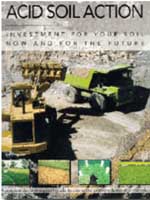
|
There are 11 sections covering:
- About this kit
- Getting stated
- Why worry about acid soils?
- Understanding acidity
- What do I need to do?
- Action guide for soil acidity
- How much lime?
- Lime guide
- Managing soil acidity – technical note series
- Lime suppliers
- Soil acidity profile maps
Format
Approx 120 loose-leaf pages in a ring binder - with coloured photographs and illustrations.
Intended Users
A guide for farmers, advisers and industry field representatives - to help assess problems caused by acid soils and decide on appropriate management strategies.
Useful Features
- Can look at the sheets singularly or work through the whole package.
- Quite broad and not overly technical.
- Designed to provide a starting point to build individual knowledge and improve discussions with the landholder’s farm adviser.
- Reasonably easy to follow, although better designation of chapters would be beneficial.
Website
Hyperlink:
http://vro.dpi.vic.gov.au/dpi/vro/vrosite.nsf/pages/soil_health_land_class |
| EMS Monitoring Tools |
Summary
A range of monitoring tools has been developed to assist landholders to monitor various aspects of their enterprise. A feature of these monitoring tools is that they are practical and simple and provide farmers with meaningful ways to measure improvement in production and the environment. They are also based on rigorous science and presented in a simple way.
Format
Presented as concise documents of 12 or fewer pages that can be easily printed from the website. Within each document is a technical explanation of the subject being monitored and then a step-by-step process of the assessment to be undertaken.
Intended Users
Farmers in the first instance but useful for students and advisers.
Useful Features
- Presented in an easy readable format
- Practical and simple
- Easily accessible via website – but not easily accessible for those without internet access.
Website
Hyperlink:
http://www.dpi.vic.gov.au/agriculture/farming-management/business-management/ems-in-victorian-agriculture/environmental-monitoring-tools
| Improving Soil Management in Sunraysia |
Technical Report Series No. 212
Graeme Sanderson, NSW Agriculture
Maxine Schache, Former Dept Agriculture, Victoria
May 1994
ISBN 0 7306 3011 0
Summary
This technical report covers a wide range of information on soils and their management in the Sunraysia region of Victoria. It covers many of the components that make up a healthy soil including:
- Classification of soils
- Organic matter and the soil
- The effects of a thick mulch during summer
- Water infiltration
- Improvement in soil Fertility
- Cover Cropping in the Sunraysia
- Potential problems associated with a change in soil management practices.
Format
30 page B% format booklet with coloured illustrations and photographs.
Intended Users
Extension officers, landholders and consultants.
Useful Features
- Contains a broad range of technical information without excessive detail.
- Provides an example of calculating readily available water.
|
|
| Know Your Soils |
Centre for Land Protection, Research (2001)
Former Dept of Natural Resources and Environment
ISBN 0 7311 4555 0
Summary
Designed to assist landholders to assess and understand their soils.
- Part 1 – ‘Introduction to soils’. Detailed information on soil, including soil forming processes, soil profile descriptions, physical characteristics of soil, and soil management and land degradation issues.
- Part 2 – ‘Assessing your soils’. Eight exercises to assess some characteristics of landholder’s soil, including soil classing, the hole, soil colour and depth, stone size and percentage, soil texture, friability, soil slaking/dispersion and soil pH.
- Part 3 – ‘Managing your soils’. Use information collected in part 2 to interpret the behaviour and physical characteristics of soil. Also provides management options for some limitations such as poor structure, poor internal drainage and acid soils.
| |
Format
Three individual booklets (25-28 pages each) that can be used either as stand-alone or in conjunction with each other. All have coloured photographs and illustrations.
Intended Users
Extension officers, landholders and consultants.
Useful Features
Contains technical information but explained extremely well.
Exercises are explained in deal and easy to follow and carry out.
Statewide relevance as information provided is broad enough to cover variation in soil, landscapes and climates. |
| Land Classing Kit for Farmers |
Nathalie Baxter
Former Dept Natural Resources and Environment, Victoria
January 2000
ISBN 0 7311 4375 2
Summary
Designed to enable farmers to identify the limitations of their land and soil in a systematic and rational way. The main aim is to ensure that the land and soil is not being used beyond its capability. | |
The classes the reader establishes relate to the number of land use options available based on the potential productive capacity of the land and the susceptibility for land degradation.
There are three major sections:
- Gathering general property information
- Determining the non-arable land classes
- Determining the arable land classes.
Format
Booklet of 24 pages, with coloured photographs and illustrations.
Intended Users
The farming community - but some training would be preferred.
Useful Features
Steps 1-4 assist in gathering the background information that is required for the rest of the booklet.
Steps 5-8 establish the appropriate land classes of the property that are non-arable.
Steps 9-11 establish the appropriate land classes of the property that are arable.
Easy to follow steps. |
| Northern Rivers Soil Health Card - A Soil Management Tool Developed by Farmers for Farmers |
NSW Agriculture and NHT
Undated
Summary
Developed as a practical tool for farmers in the northern rivers region of NSW, and enabling them to monitor the health of their soils. The card was developed through a series of workshops involving Landcare members, farmers and staff of NSW Agriculture and Wollongbar TAFE.
Format
A 12 page loose leaf document that includes black and white photographs and illustrations. |
Intended Users
Suited to farmers across a range of industries. Little or no training is required to undertake the simple tests.
Useful Features
- Very simple in presentation
- Clear, concise and simple to use.
- Follows a logical order describing test preparations the soil tests and the results
- All the soil tests (9) and plant tests (1) are easy to apply and require minimal equipment.
- Scoring and interpretation sheets are provided.
Website
The Northern Rivers Soil Health Card can be downloaded from the following hyperlink.
Hyperlink: http://www.agric.nsw.gov.au/reader/soil-testing/north-rivers-soil-health-card.pdf?MIvalObj=25791&doctype=document&MItypeObj=application/pdf&name=/north-rivers-soil-health-card.pdf (link no longer active) |
| Soil Health Assessment Kit – Users Guide |
Peter Grace & Keith Weier
Institute for Sustainable Resources, Qld University of Technology
DRAFT - Feb 2007
Summary
A soil health assessment kit and scorecard have been developed as part of the Healthy Soils for Sustainable Farming Systems Project: ‘Defining and promoting soil health for sustainable production systems’. The kit and scorecard are currently in draft form and require further in-field testing.
The soil health scorecard is a simplistic qualitative rapid assessment tool which provides the adviser or landholder with a running record of soil condition and how a particular paddock responds to management. |
The kit uses a set of quantitative indicators selected primarily for their ability to respond to management in the longer term. The kit should be used as a screening tool to give general trends or direction of soil health – whether current management systems are maintaining, enhancing or degrading the soil.
The tests within the kit include:
1. Soil respiration
2. Infiltration
3. Bulk density and soil moisture
4. Electrical conductivity
5. Soil pH
6. Soil nitrate
7. Soil stability
8. Earthworm count
9. Soil physical observation
10. Mineralisable nitrogen
Format
The user guide is currently a 45 loose-leaf page document with colour photographs. The associated kit is packed into a standard size plastic tool box.
Intended Users
Although intended as a soil health assessment tool for farmers, advisers and industry field representatives, the kit requires an experienced operator if full benefit is to be obtained.
Useful Features
- Proper use of both the scorecard and kit and interpretation of results depends on how well the indicators are understood with respect to the land use and environmental goals.
This latter aspect is evolving within each industry, due to the lack of data from around the world, but the more information that users can supply in their relevant localities, industries or communities, the better the interpretations that can be provided in the future. |
| Soil Structure Assessment Kit - A Guide to Assessing the Structure of Red Duplex Soil |
Shelley McGuiness
Former Dept Conservation and Environment, Victoria
July 1991
ISBN 0 7241 9937 3
Summary
Developed as an educational aid for farmers in the irrigation districts with red texture-contrast (i.e. duplex) soils.
Format
Booklet of 20 pages, including coloured photographs and illustrations. Loose leaf recording sheet included.
Intended Users
Intended for farmers and extension officers. Although designed as a self-explanatory kit, it is preferable for users to be taken through it with an extension officer in the first instance. | |
Useful Features
- Technical information combined with exercises for hands-on learning
- Provides useful information on ten soil properties and how to rate them to determine the properties that limit plant growth.
- Can assist to monitor the changes in structure over time and determine whether it is improving.
- Designed specifically for texture contrast soils in irrigation districts.
It does not give specific solutions to soil problems but provides information to develop a management strategy to overcome specific problems. |
2. Programs/Learning Guides
| Better Soils Mean Better Business |
Better Soils Technical Committee (Agricultural Bureau Project) - SA
October 1998
Summary
Developed as a foundation document for the ‘Better Soils Program’ in South Australia. It contains information about all major soil conditions experienced in SA. In many situations it explains how to measure and monitor their conditions. | |
The sections of the manual include:
- How ‘Healthy’ is your soil?
- Properties of a ‘healthy’ soil
- Describing a soil
- Soil structure and friability
- Freedom from Barriers
- Storage of Water and Nutrients
- Erosion potential
- Biological Activity
- Soil diseases and suppressive soils
- Glossary of Terms
- References.
Format
Booklet of 48 pages including coloured photographs and illustrations.
Intended Users
This manual is designed for farmers, as part of a group format of the ‘Better Soils Program’.
Useful Features
Extensive soil pit photos of the main agricultural soil in SA.
The principles of good soil health are generally the same whether they are referring to a vineyard, dairy pasture or cropping soil.
Website
Hyperlink : http://www.bettersoils.com.au/modules.htm (link no longer active) |
| Crop Monitoring Guide |
Better Information – Better Decisions
Rural Solutions SA
5th Edition, 2006
ISBN 0 7590 1377 2
Summary
An essential guide and reference to the practices, growth stages and benchmarks for crop performance. It is also a guide to the detailed assessment of each critical growth stage of a crop. | |
This guide includes five soil checks that are undertaken as part of a monitoring program:
- Crop suitability to different soils
- Land class
- Properties of soils
- Soil sampling
- Interpreting soil test results.
Format
Book of 154 pages that includes black and white photographs and illustrations. Relevant Sections of the book are from pages 47 – 62.
Intended Users
Designed as a ready and valuable reference for any farmer’s day-to-day decision making. Also intended for groups, whether a PMP, Landcare group or local crop group.
Useful Features
- Contains all the relevant tables for soil texture grades and determining water holding capacity.
- Very general description of dispersive soils.
- Generalised land class definition.
- Table showing crop suitability with respect to soil texture, pH and waterlogging.
|
| Fertilising Grazed Pastures |
DPI Beef Industry Officers
The Target 10 Soils and Fertiliser Activity Group
2003 Edition
Summary
This publication is a result of the adaptation of the Target 10 ‘Fertilising Dairy Pasture’ manual. The aim is to enable farmers to make more informed cost-effective fertiliser management decisions. Pasture production depends on sound use of fertilisers and it is important to understand soil condition if best results are to be achieved from fertiliser use.
Relevant sections of the manual are:
- Chapter 3: How do the properties of soils affect plant growth?
- Chapter 4: managing soil factors that can limit plant growth
- Chapter 5: Soil types of Victoria.
Format
Loose leaf format in a ring binder (240 pages) including mainly black and white illustrations and photographs.
Intended Users
Developed as a source of reference material for use by farmers during the Program, but will serve as useful resource material for other training events.
Useful Features
- Learning outcomes are featured the beginning of each chapter.
- Provides a broad description of soil physical and chemical properties and factors affecting plant growth.
- General soil descriptions of the state.
|
| Measuring and Managing Soil Water |
Training Manual
CSIRO, GRDC, undated
Summary
An action learning program designed for farmers and consultants to gain an improved understanding of soil water management in dryland cropping systems.
This program is run over two workshops, each containing sessions and associated activities. Some of the workshop sessions are pre-season, the field activities (during the season) and review and presentation (post-harvest). Some of the session work includes:
Understanding soil and water processes
Developing practical skills in soil water measurement
Using soil water information in management decisions.
Field activities including characterising a soil for Plant Available Water Capacity and monitoring for plant available water over a season.
Format
Loose leaf booklet of 77 pages including black and white photographs and illustrations.
Intended Users
Designed for farmers and consultants to learn the tools in workshop sessions and then having the experience to undertake them on their own farms.
Useful Features
- Tools for effective measurement of soil water.
- Links to ‘Soil Matters Manual’.
- Completion of the soil water program the theory can be practically used to assist in the management of soil and soil water.
Detailed description of soil sampling for soil salinity and interpreting soil test results. Soil Acidity and Liming |
| Salt Kit - A “Do-It-Yourself” Salinity Identification Kit for Farmers of the North Victorian Irrigation Region |
Former Victorian Department of Agriculture, Energy and Minerals (1995)
ISBN 0 7306 6455 4
Summary
The Salt Kit consists of two parts:
i). folder containing a general description of the visual soil and plant symptoms related to salinity, sodicity and waterlogging; a description of how to install a test-well, how to collect and test water and soil samples, and a guide to interpreting the results and record sheets.
ii). set of containers and plastic bags used for sampling and mixing soil as well as water samplers. | |
The kits sections include:
- Chapter 1: Setting the scene
- Chapter 2: Defining terms and salinity units
- Chapter 3: Looking for the signs
- Chapter 4: What is happening to the watertable under your farm?
- Chapter 5: What is happening to the soils on your farm?
- Chapter 6; Where do you go from here?
- Publications.
Format
The Manual is a loose leaf A4 binder consisting of 60 pages with coloured photographs and illustrations. The Salt Kit has been designed so that each Chapter can ‘stand-alone’.
Intended Users
Designed for farmers so it can be used individually or as part of a Group activity – and aimed at providing a basis for decision making across a whole catchment.
Useful Features
- Extensive glossary of terms relevant to salinity, waterlogging and sodicity.
- Good set of photos showing degrees of salinity on pastures and vegetation.
- Detailed description of installing test-wells and testing water salinity.
|
| Soil Acidity and Liming |
Agfact AC. 19, second edition 1996
Agdex 534
NSW Agriculture
ISSN 0725-7759
Summary
Detailed document covering all aspects of soil acidification - including causes and amelioration. The sections of the booklet include:
- Managing soil acidity – the practical options
- Distribution of acid soils in NSW
- Signs of soil acidity
- Causes and control of agriculturally induced soil acidity
- Rates of soil acidification
- Influence of soil acidity on plant growth
- Using lime
- Using acid tolerant plant species.
| |
Format
24 page booklet with coloured photographs and illustrations.
Intended Users
Extension officers, consultants and farmers. There may be some clarification required for farmers regarding the technical aspects of soil acidification.
Useful Features
- Extensive all round publication that explains all the facets of soil acidity, its causes, signs, rates of and influence of soil acidity on plant growth and the management strategies to overcome soil acidity.
- The material can be applied to areas of soil acidification across Victoria.
|
| Soil Guide: A Handbook for Understanding and Managing Agricultural Soils. |
Geoff Moore (editor)
Agriculture Western Australia
First published March 1998
Reprinted July 2001
ISBN 0 7307 0057 7
Summary
This handbook is designed to identify the soil properties affecting management, production and sustainable land management at the paddock scale. It provides links between different soils, their properties and management options. The information can be expanded to a catchment or regional scale using knowledge of the spatial distribution of soils. Although the handbook is specifically designed for rain-fed agriculture in south-western Australia, many sections are relevant to other regions of Australia.
The handbook chapters include:
- Chapter 3: Physical factors affecting water infiltration and redistribution
- Chapter 4: Physical restrictions to root growth
- Chapter 5: Chemical factors affecting root growth
- Chapter 6: Plant nutrition
- Chapter 7: Sustainable soil management
- Chapter 8: Crops: soil and climatic requirements
- Chapter 9: Pastures: soil & climatic requirements
- Chapter 10: Understanding and interpreting soil chemical and physical data.
Format
A 380 page book with photos, diagrams and tables and illustrations.
Intended Users
Users of this handbook do not require a detailed technical knowledge of soils, however, simple skills such as field texturing and a basic knowledge of soil science is required. Useful as a reference resource for field staff and advisers.
Useful Features
- Useful reference material for a wide range of soil related topics.
- Relevant to most cropping regions of south-eastern Australia.
|
| Soil Matters - Monitoring Soil Water and Nutrients in Dryland Farming |
Neal Dalgliesh and Mike Foale
CSIRO Australia, 1998
ISBN 0 643 06375 7
Summary
Describes ‘best practice’ for monitoring soils for water and nutrients. The manual is a starting point for developing the linkage between applied research and the needs of the industry to make better use of the soil resource. Adoption of the methods and the subsequent use of the results by farmers will represent a great advance in soil monitoring and accessing cropping potential. It should result in a much better understanding of what is happening in the soil and plant environment, any opportunities and risks, and should lead to better resource management.
The manual comprises a set of modules that provide background information on, and describe the best practice in, soil monitoring. There are 5 modules and appendices in the main book:
- Understanding your soils
- A guide to soil sampling
- Calculating water and Nitrogen
- Determining plant available water capacity
- Soil characterisation.
Format
122 page book with colour photographs and illustrations. Also includes a Land Resource Area Map for the Central Darling Downs.
Intended Users
For farmers and consultants in the field of the northern cropping region of New South Wales and Queensland.
Useful Features
- Manual describes the standard methods of measuring moisture levels etc but also provides alternatives to improve both the quality and quantity of the information.
- Simple explanation of the key soil processes to better understand this resource and practical guidance to making relevant soil measurements.
- Good description of soil physical, chemical and biological properties of soils.
- Good description of soil sampling techniques including placement, depth, sampling intervals, storage of samples.
- Calculating water use efficiency of the crop growing, nitrogen calculations.
|
| Soils and Fertilisers Exposed |
Frank Mickan
Agriculture Victoria, 1995
ISBN 0 7306 6401 5
Summary
Provide users with an understanding of:
Soils and fertilisers
What nutrients are required by plants to produce fast growing high quality pastures
Principles of how to determine which nutrients, and how much, are required by plants
How to compare the costs of relevant nutrients from the multitude of nutrient sources in the market place. | |
Format
106 page booklet with black and white photographs and very few illustrations.
Intended Users
Intended for the course users of ‘Target 10’ workshops.
Useful Features
The first few chapters provide a very broad overview of the soil properties (structure, pH, nutrients).
Its focus, however, is to concentrate of soil fertility and the appropriate nutrients to apply to produce a healthy dairy pasture. |
| Soil Pit Field Day Notes |
Former Agriculture Victoria (1993-2006)
Mark Imhof et al
Summary
A series of 35 booklets providing information on key soil types associated with Landholder Groups (Landcare, Farm Advance) in North Central, North East, Goulburn Broken, Mallee, West Gippsland and Wimmera regions as well as for DPI led excursions and field days. Booklets were associated with Soil Pit Field Days held with groups and as ‘companion material’ for excursions. | |
Format
- Overview of the geology and geomorphology of the region.
- Information associated with up to 7 soil pit sites in each region – soil profile morphology and photos; soil analytical data and graphs of profile trends; management considerations.
- Soil Glossary.
Intended Users
Landholders, Departmental and other support staff were primary audience. Much of this information is now also been included on the Victorian Resources Online (VRO) website where available to wider range of users.
Useful Features
- Provides information on major agricultural soils associated with each Group’s area – raising awareness of key soil properties and associated management considerations.
- Initially used as accompanying material at Soil Pit Field Day events – but provides on-going value as a record of major soils in each area.
- Illustrated soils glossary provides explanation of key terms.
|
| Soil Sense Notes |
Roger Hall
Former Agriculture Victoria
August 1997
Summary
This manual is an extensive guide that covers the awareness and assessment of a range of soil issues and the management strategies that can improve farm management decisions.
There are six sections within this manual and there are a few topics covered in each of the sections including:
- Chemical (pH, macro and micro nutrients, acidity and sodicity)
- Physical (erosion, compaction, structure decline, water and EC)
- Biological (earthworms and biological activity)
- Management (soil fertility, applying fertilisers)
- Training
- Further Reading.
Format
Loose leaf in a ring binder (25 individual notes). Each subject has its own loose leaf document of 6 pages or less with coloured photographs and illustrations.
Intended Users
A guide for landholders, advisers and extension officers to help assess the state of the soil and decide on appropriate management strategies.
Useful Features
- Can look at the note series singularly or work through the whole package.
- Quite broad and not overly technical.
- Designed to provide a starting point to build individual knowledge and improve discussions with the landholder’s farm adviser.
The colour coding of the different sections is reasonably easy to follow. |
| Soil Workshop Notes - Soil Observation & Interpretation |
Nathan Heath
DPI Wodonga
September 2006
Summary
The workshop and workshop notes intend to incorporate soils information into farm management by:
- increasing farmer’s confidence to make soil-based management decisions
- increasing awareness of the soil resource
- increasing farmer’s ability to identify soil degradation problems
- increasing farmer’s ability to monitor the health of soil
- encouraging more efficient use of fertilisers.
There are two workshops involved in the program:
Workshop 1
- Soils & landforms on your farm
- Looking at your soils ‘health’
- Looking at your soils ‘capability and versatility’
- How to take a soil test.
Workshop 2
- Interpreting soil tests
- Discussion about the differences between farmed and non-farmed soils.
Format
- 100 page booklet with coloured photographs and illustrations.
- This booklet is a print out of the slide show given at the workshops.
Intended Users
Farmers attending a workshop, where they are taken through the notes and explanations.
Useful Features
- Information is quite broad but a useful reference material for a wide range of soil related topics.
- Photographs are quite detailed – although no explanations provided.
|
| Southern Dryland SOILpak |
Nathalie Brown & Tom Green
NSW Agriculture 2001
ISBN 0 7347 1091 7
Summary
A guide to best practice soil management for dryland farmers (mixed cropping and grazing in the Murray and Murrumbidgee catchments). The manual is designed to be used as a first source of information to enable users to identify the nature and cause of soil problems.
Aim is to provide information that will help to increase farm profitability by improving farm management. It is based on an accumulation of information derived from numerous research workers, public and private sector advisers and agribusiness over many years. | |
The sections of the Manual include:
Part A – Introduction/an ideal Soil
Part B – Quick help
Part C – Looking at your soil
Part D – Practical soil management
Part E – Background information.
Format
Five part section loose-leaf pages (approx 200) in a ring binder, black and white photographs and illustrations.
Intended Users
To help farmers to understand the basics of soils and assist farmers, consultants and extension officers with soil management decisions.
Useful Features
To be used as a recipe book, rather than read cover to cover, to deal with specific soil issues as they arise.
- Suggests ways to overcome a wide range of soil limitations to plant growth.
- Quite technical, however, the management strategies can be applied to most soils across Victoria.
- Advice is underpinned by a strong commitment to long-term stability in agriculture.
|
| Topactive - Workshop Activities For Groups
|
PIRSA Rural Solutions (1999)
Summary
TOPACTIVE group workshops are training resource packages for use in the grains industry for presenting agronomic technology to grower and industry groups. These workshops can be presented as a one off, or grouped together to form a training program.
TOPACTIVE group workshops are presented as a useful structure that provides ideas, references and contacts, and can be modified to meet the individual needs of different groups. Not all details are provided – TOPACTIVE workshops are meant to complement, not replace the trainer’s knowledge, skills and ideas. | |
Format
Booklets of 12 or fewer pages, with loose leaf evaluation and worksheets. TOPACTIVE workshop activities for groups include:
- Crop Establishment (CM699TA)
- Crop Nutrition and Vigour (CM799TA)
- Farm Water Use, Productivity and Dryland Salinity (GA899TA)
- Managing Nutrition post sowing for yield and quality (NUT299TA)
- Planning Nitrogen Nutrition (NU499TA).
Intended Users
Workshops are intended for landholders, extension officers and industry groups.
Useful Features
For experienced extension workers, the ideas, materials and references provided may help save time in preparing for group workshops.
For inexperienced extension workers, TOPACTIVE should provide most of what you need to run effective group workshops. |
| Understanding and Managing Soils in the Central Highlands - Field Manual
|
G.F. Bourne & G.A. Tuck
Dept Primary Industries Queensland
Undated
Summary
The Land Management Field Manuals are targeted for the cropping lands of Queensland and focus on identifying appropriate land units and their limitations and to document techniques for best land resource management practice. A typical Land Resource Management Field Manual comprised three sections:
- Resource Information document - outlining district, climate, geology, land resources, soil classification, land use, land use recommendations etc.
- Field Manual - containing summarised information on soil types along with colour photographs of soil profiles and landscapes on laminated cards. Additional information was provided on land suitability, recommended best land use practice, and conservation measures.
- Land Resource Areas (LRA) map: a full colour, printed map at a standard scale (1:100 000) of LRAs in the district attached in a plastic wallet.
| |
Format
The three sections are held in a ring binder.
Intended Users
Manuals designed to be "self-help" documents, and to take over where the soil specialist leaves off. The manuals were targeted towards a broad audience, at a low-technical level, and designed for use in the field (loose- leaf laminated cards with colour photographs of the soils and landscapes, and summary land type descriptions, along with a full-colour printed map of the land resource).
Useful Features
- Agricultural Management Unit photo and summary cards in the field manual, followed by the crop suitability information; the land conservation guidelines in the "Resource Information" document, and the "Glossary of Terms".
- Most landholders viewed the manual not only as a general reference text, but also as a valuable communication tool between themselves and extension officers.
|
3. Brochure/Booklets
| Farming Today for Tomorrow
|
Kondinin Group, No. 60
December 1996
Summary
‘Farming Ahead’ - a monthly magazine produced by the Kondinin group as the primary means by which farmers can access independent research and the most up-to-date developments in agriculture. A range of topics are covered monthly that include evaluation and comparisons of equipment, computer programs, the latest technology and science available.
This edition of the magazine has two relevant sections:
Soil structure (18 pages)
Soil fertility (15 pages) | |
Format
Each section of the magazine is coloured coded and includes easily identifiable logos so that it is easy to find the relevant information. There are coloured and black and white photographs and illustrations throughout.
Intended Users
The Kondinin network of farmers, agribusiness, consultants, researchers and staff are committed to ensuring farmers have access to the best information available.
Useful Features
Provides information on soil structure decline (erosion, crusting, structure, ponding, organic matter, earthworms, trafficability), improving soil structure (gypsum).
Comparison of no-tillage, minimum till system, controlled traffic.
Provides information on the importance of soil fertility for long term profits (plant requirements, organic matter, low soil fertility, nutrient status, testing, soil pH, salinity, sodicity, waterlogging). |
| Ground Cover Magazine
|
GRDC
Relevant Supplements
Contact: Maureen Cribb GRDC 02 6272 5525
Soil Biology Supplement
Healthy soil healthy business.
Latest research on soil nutrition and management.
June/July 2005
16pages
Subsoil Constraints Supplement
The enemies underground.
Hostile subsoils have a significant impact on yield and profits.
April-May 2006
16 pages
Nutrient Management Supplement
Matching the input to the output.
Deciding the right amount of fertiliser for the best results.
Dec/Jan 2005-06
16 pages | |
| Subsoil Constraints - Limiting crop profitability on alkaline soils in South Eastern Australia
|
GRDC, Profitable Soils Group
Undated
Summary
Susbsoil constraints occur naturally on the neutral and alkaline soils of south-eastern Australia and can reduce grain yields and quality. The majority of subsoil constraints appear to have their greatest impact by inhibiting root growth and therefore can limit the amount of water and nutrients the crop can access.
The brochure covers a range of issues including:
- What are subsoil constraints
- How do I identify subsoil constraints
- Amelioration of the subsoil
- Agronomic management
- Issues to consider.
| |
Format
A4 glossy Booklet of 8 pages with coloured photographs and illustrations.
Intended Users
A guide for extension officers, consultants and landholders to help assess subsoil constraints and to decide on appropriate management strategies.
Useful Features
Provides information on how to identify and ameliorate subsoil constraints.
Weblink http://www.dpi.vic.gov.au/dpi/vro/vrosite.nsf/pages/soil_mgmt_subsoil |
4. Information Notes
1. DPI Information Note Series
The following hyperlinks take you to a particular topic relating to soil health. Within each of these categories there are many relevant information series.
This information is relevant to farmers, the wider community, extension staff and consultants and can be easily accessed through the DPI website. For those without internet access, the material can be obtained by contacting the relevant office.
Soils (General)
There are 21 information notes in this series ranging from 2 to 5 pages. There is a wide range of information obtained in this section, including the broad topics of what is a soil, healthy soils, the living soil, to more specific issues of soil physical properties, guidelines for soil sampling, land classes for farm planning and land degradation.
http://www.dpi.vic.gov.au/dpi/nreninf.nsf/childdocs/-2BAF4D73531CD1544A2568B3000505AF-57D1EB72F146450ECA256BC80004E8DD?open
Erosion
There is some relevant material pertaining to gully, water, stream bank, tunnel and wind erosion and approaches to their control. There are other notes on landslips and measuring dust movement.
http://new.dpi.vic.gov.au/agriculture/farming-management/soil-water/erosion
Salinity
In this note series salinity is explained, the risk of salinity in the Wimmera plains is stated and included are some recommendations for management of salinity.
http://www.dpi.vic.gov.au/dpi/nreninf.nsf/childdocs/-2BAF4D73531CD1544A2568B3000505AF-9A924F4B3FB28503CA256BC80004E921?open
Drainage & Wet Soils
This information note series provides information on pugging, drainage, farm planning wet soils and a number of options to reduce the severity of the problem
http://new.dpi.vic.gov.au/agriculture/dairy/managing-wet-soils
Soil Smart Notes
This series of 11 Soil Smart notes was developed as a handbook for landholders, covering topics such as what is a soil, horizons, colour, texture, structure/porosity, slaking and dispersison, fabric, consistence, pH, soil biology and interpreting a soil chemical test. It quite comprehensively covers all these topics.
Intended users are farmers, some assistance may be required by extension officers or consultants.
2. NSW Agriculture Note Series
The following hyperlink takes you to the NSW Agriculture website relating to soil health. Within each of these categories there is relevant information.
This information is relevant to farmers, the wider community, extension staff and consultants and can be easily accessed through the NSW Agriculture website. For those without internet access, the material can be obtained by contacting the relevant office.
Series of notes for farmers outlining different soil health issues facing the agriculture sector. These include topics such as:
- Fertilisers and soil improvement
- Soil types, structure and condition
- Soil biology
- Soil management guides
- Acid sulphate soils
- Sodic soils
- Erosion
- Testing and assessing soil salinity
Hyperlink: http://www.agric.nsw.gov.au/reader/soil-health-fertility (external link)
3. Birchip Cropping Group
The following hyperlink takes you to the Birchip Cropping Group website.
The information available is relevant to farmers, the wider community, extension staff and consultants.
Hyperlink: http://www.bcg.org.au/news.php?news_type=current (external link)
4. Mallee Sustainable Farming Inc.
The following hyperlink takes you to the Mallee Sustainable Farming website and directly to the ‘Farmtalk’ Fact Sheet Series.
This information is relevant to farmers, the wider community, extension staff and consultants and can be easily accessed through the Mallee sustainable Farming website. For those without internet access, the material can be obtained by contacting the MSF Head Office.
There is a series of Fact Sheets that outline different soil and cropping issues facing the agriculture sector in the Mallee regions of Victoria, New South Wales and South Australia. These include:
- Benefits of Managing your microbes in the SA Mallee Region.
- Machinery considerations for improved residue handling at seeding.
- Soils ain’t soils: The Mallee experience.
- Mallee Farming: Productive, Profitable and sustainable!
- Making use of EM in the Mallee.
- Measuring your own soil moisture to better target yield potential.
- Managing soil biology – benefits from nutrient efficiencies and disease suppression.
Hyperlink: http://www.msfp.org.au/media.php?page=farmtalk (external link)
5. Southern Farming Systems
The following hyperlink takes you to the Southern Farming Systems website.
The information available is relevant to farmers, the wider community, extension staff and consultants.
Hyperlink: http://www.sfs.org.au/publications.php (external link)
5. Educational Manuals
This section of the document covers the educational material that is available to school age students, right through primary and secondary school age.
Dynamic Agriculture
Book one
Blackine masters
2002
ISBN 0 07 471019 2 | Living Soil
A closer look at soils and their management
School Resource Material by Julie Sharp | Our Land
Landcare activities for Upper Primary
NSCP, DCF&L 1989 |
Planning for sustainable Land Use
Combining family, profit and the environment
DPI, Landlearn, March 2004
Class and field activities for secondary students | Pride in Victorian Farming
Food and Agriculture in the Classroom
Teacher resource book, level 4, Grades 5 & 6 | Salinity
Environmental Education Resource
NCCMA, 2003
ISBN 097 504 564 4 |
SaltWatch
A Resource Book for Schools
1998 DNRE, Victoeria | Soil Magic
Landcare Activities for Middle Primary
NSCP, DCF&L 1989 | Soil Project Sheets
Ideas for use in schools
Land Protection Division, CF&L, NSCP, 1988
Soils Ain’t dirt
DPI, Landlearn, March 2003 |
Soils Ain’t Dirt
The Landcare Songbook for Kids
NSCP, DCF&L 1989 | The Mallee
An education kit produced by the Aust National Botanic Gardens |  |
6. Departmental Videos
Achievements in Salinity Control
Tape no. 2
Swan Hill Office (139) | ATV 10 Newsfilm of 1982 drought in Mallee
Swan Hill Office (54) | CF&L Ouyen
Swan Hill Office (51) |
Sustainable Productivity in Agriculture. “Landcare”
Swan Hill Office (46) | Mallee Landcare Documentary
Landscape Change through community Partnerships (44) | Murray Darling Basin Commission
SALT
Swan Hill Office (42) |
Principles of Sustainable Agriculture
Managing Soil Structure
Department of Ag and rural Affairs NSCP
Swan Hill Office(43) | There’s no Money in Dust
Nicholas Bate
SHO (66) | Dryland Salinity it … or us!
Murray Darling Basin Commission
SHO (118) |
A Fresh Start
SHO (83) | The Ultrasound of the Earth
A surgical approach to salinity
Oct 2001
SHO(117) | Dancing in the Dust
6/11/2000 – Jenny Kendall
SHO(126) |
Persistence Pays
CF&L
SHO | 4 part series of “Heartlands”
SHO (57) | Worms at Work. How to use the earthworm for good waste management and better soil
SHO(144) |
Principles of Sustainable Agriculture
Pasture Improvement in Vic
Dept Ag
SHO(128) | WARMPlan
Dryland Salinity, combating the ‘grim creeper’
June 2001
SHO(114 & 133) | The Big Dry
Dept Cons & Env
SHO(96) |
7. Posters
- Preventing Soil Erosion
- Types & Causes of soil erosion in Australia
- SOIL Our Greatest Asset

